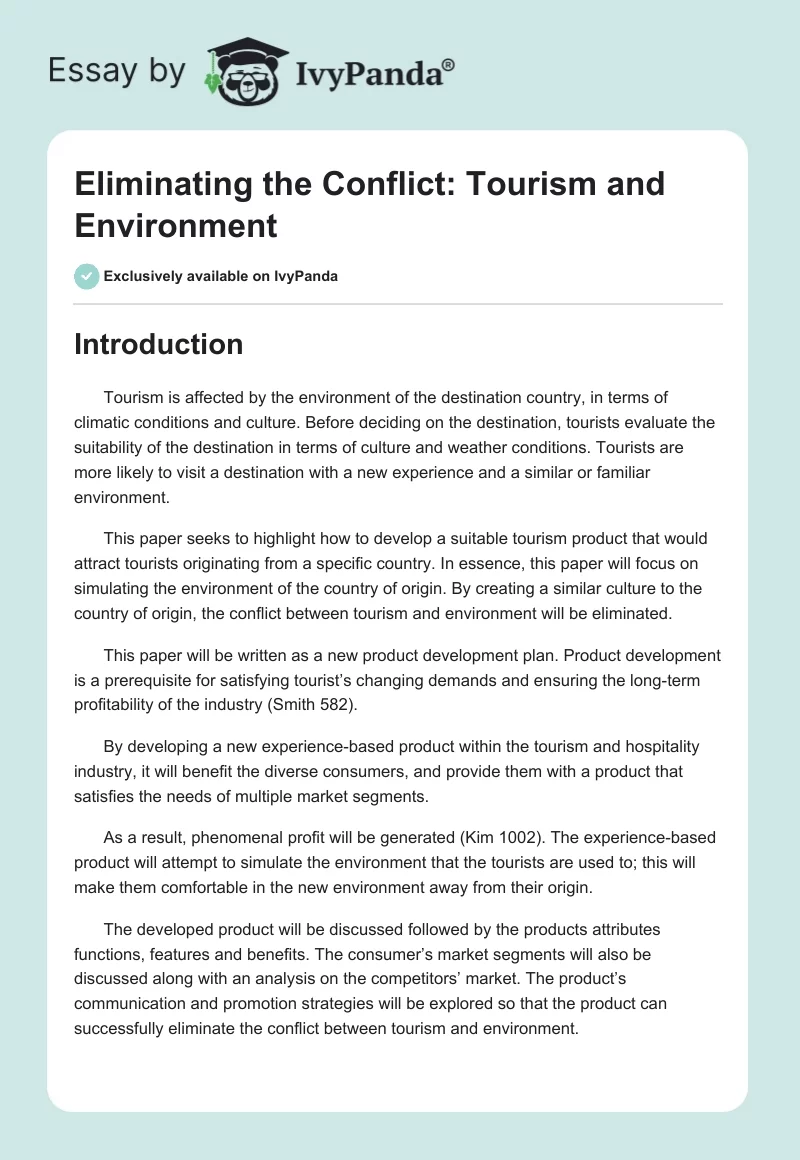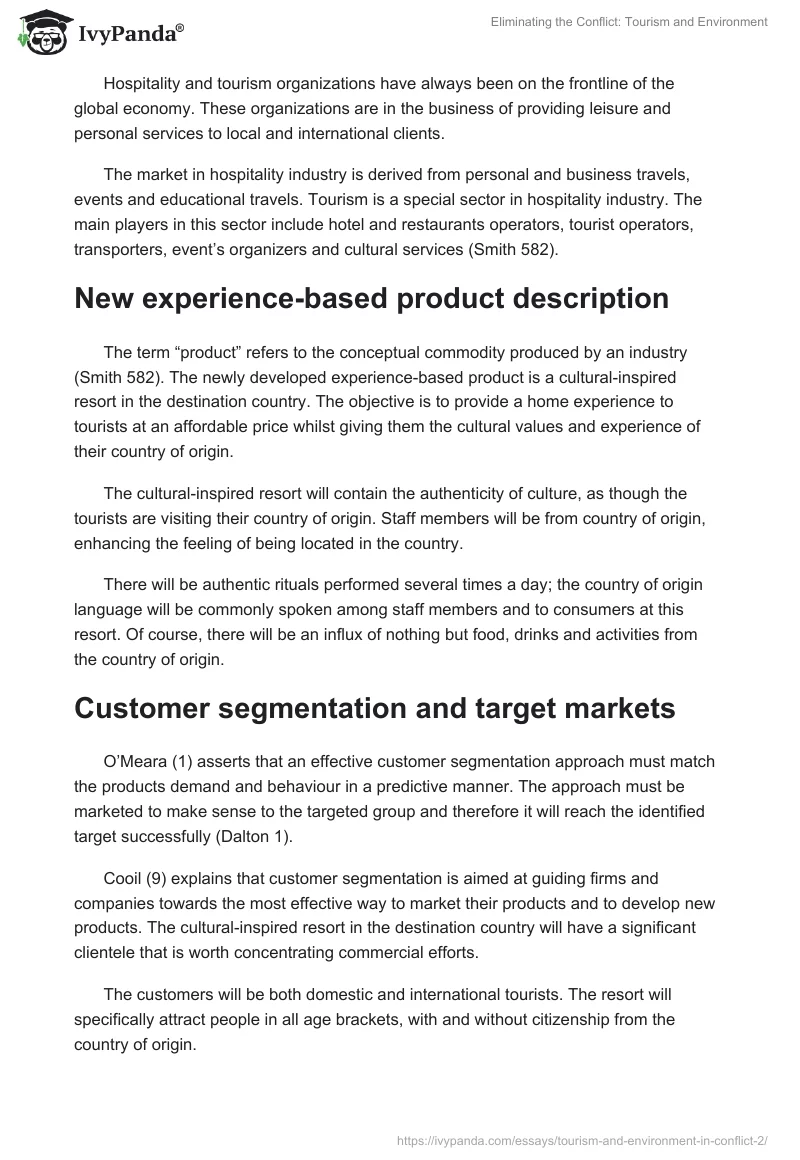Introduction
Tourism is affected by the environment of the destination country, in terms of climatic conditions and culture. Before deciding on the destination, tourists evaluate the suitability of the destination in terms of culture and weather conditions. Tourists are more likely to visit a destination with a new experience and a similar or familiar environment.
This paper seeks to highlight how to develop a suitable tourism product that would attract tourists originating from a specific country. In essence, this paper will focus on simulating the environment of the country of origin. By creating a similar culture to the country of origin, the conflict between tourism and environment will be eliminated.
This paper will be written as a new product development plan. Product development is a prerequisite for satisfying tourist’s changing demands and ensuring the long-term profitability of the industry (Smith 582).
By developing a new experience-based product within the tourism and hospitality industry, it will benefit the diverse consumers, and provide them with a product that satisfies the needs of multiple market segments.
As a result, phenomenal profit will be generated (Kim 1002). The experience-based product will attempt to simulate the environment that the tourists are used to; this will make them comfortable in the new environment away from their origin.
The developed product will be discussed followed by the products attributes functions, features and benefits. The consumer’s market segments will also be discussed along with an analysis on the competitors’ market. The product’s communication and promotion strategies will be explored so that the product can successfully eliminate the conflict between tourism and environment.
Hospitality and tourism organizations have always been on the frontline of the global economy. These organizations are in the business of providing leisure and personal services to local and international clients.
The market in hospitality industry is derived from personal and business travels, events and educational travels. Tourism is a special sector in hospitality industry. The main players in this sector include hotel and restaurants operators, tourist operators, transporters, event’s organizers and cultural services (Smith 582).
New experience-based product description
The term “product” refers to the conceptual commodity produced by an industry (Smith 582). The newly developed experience-based product is a cultural-inspired resort in the destination country. The objective is to provide a home experience to tourists at an affordable price whilst giving them the cultural values and experience of their country of origin.
The cultural-inspired resort will contain the authenticity of culture, as though the tourists are visiting their country of origin. Staff members will be from country of origin, enhancing the feeling of being located in the country.
There will be authentic rituals performed several times a day; the country of origin language will be commonly spoken among staff members and to consumers at this resort. Of course, there will be an influx of nothing but food, drinks and activities from the country of origin.
Customer segmentation and target markets
O’Meara (1) asserts that an effective customer segmentation approach must match the products demand and behaviour in a predictive manner. The approach must be marketed to make sense to the targeted group and therefore it will reach the identified target successfully (Dalton 1).
Cooil (9) explains that customer segmentation is aimed at guiding firms and companies towards the most effective way to market their products and to develop new products. The cultural-inspired resort in the destination country will have a significant clientele that is worth concentrating commercial efforts.
The customers will be both domestic and international tourists. The resort will specifically attract people in all age brackets, with and without citizenship from the country of origin.
Anticipated customers for the cultural-inspired resort will be divided into several segments with similar needs or service requirements. These segments will have common characteristics and will exhibit similar reactions to marketing and promotions.
Dividing the anticipated clientele for the cultural-inspired resort will leverage limited resources; this means that the essentials of the promotion mix and advertising will be designed to satisfy specific requirements of different clients groups (Baines and Fill 218).
Customers for the new cultural-inspired resort will be segmented based on demographic information. These include variables such as their gender, occupation, education level, religion, income and social class. This information will give the management an overview of financial capability of their clients.
Another segment will be life-stage based on the fact that different ages of people have different needs. Consequently, financial capability is most likely going to be determined by the age of a person (Baines and Fill 218). Another segment will be based on geographic factors; this follows that the resort expects to get local clients as well as tourists from the country of origin.
After customer segmentation, the resort will determine whether any of the segmented market should be targeted and made the center of an inclusive marketing program. Eventually, the resort will choose the market segments to be exploited and the ones to be ignored; in essence this is the ones to be exploited will be the target markets.
The resort will choose markets which are accessible or where customers are reachable through promotion and advertisements on media. Cultural-inspired resort will also target measurable markets; the ones that will be easily identified and analyzed.
The resort will target middle aged people who have a keen interest in following the new trends and who can be easily accessed through the media. The clientele will be those who have attained eighteen years and above due to their financial security (Baines and Fill 218).
Competitor Analysis
Ghosh and Morita (139) observe that competitors of a product of similar nature often collaborate by sharing an element of their value-creating activity or product design. However, the cultural-inspired resort still has its product differentiation as it will provide different services compared to any other bed and breakfast resort within the destination country; it will have a huge emphasis on marketing this product to the consumer.
If the resort is threatened by another competitor in future, the management may decide to collaborate and work together with the competitor. The two may form a joint company characterized by product distinctiveness of the cultural-inspired resort and the competitor’s beach side resort; the consumers would see distinctiveness between the products.
Competitor analysis of the cultural-inspired resort gives more insight into the strategies of the competitor. The analysis will help the resort to view the trends and future of the hospitality industry in the destination country. The first step is to identify the competitors; these are other beachside resorts and bed and breakfast getaways.
The strategies used by these competitors will be identified to provide the true picture of current trends in the hospitality industry and the general market place. The resort will use the analysis of these strategies to design its own unique strategies to confront the market (Stralser 164).
Communication and promotion strategies
As expressed by Abdalnaser (1684), the basic objective of promotion is to be able to communicate information and properly inform the consumers of the product. The communication should be carried out in the most effective way for consumers to identify the product by connecting images and catchy slogans of the promotion.
The cultural-inspired resort will inform, persuade and influence its prospective customers. The strategies will be aimed at making the tourists to selectively come to the resort. The promotional mix that the resort will use includes service promotion, advertising and public relations (Scrib Inc 2).
Cellich and Borgeon (37) discuss promotional strategies as being based on a continuous process involving the design of a product, monitoring, evaluation and feedback. The cultural-inspired resort will have to continuously update and maintain their design, making sure the theme is successfully carried through.
This will be closely monitored by managers and consumers. Along with feedback from customers, this will provide additional evaluation. The objective of promotional strategy will be to capture a new market, keep the market and expand the market (Scrib Inc 2).
People often impulse buy a holiday and destination when an urge for a holiday strike them. Liao (3) states that, it is communication and consumer characteristics that promote impulse buying, along with motivation and product appeal. The resort will continue to maintain a good reputation.
It will have everything, a relaxing holiday and plenty to do if need be. This will all be in a setting that feels like the consumer has escaped the country of origin, and entered an entirely different and authentic country, all at a reasonable cost.
Cultural-inspired resort will use the promotional strategy to differentiate its products and service from those of competitors. The resort will apply the concept of positioning to communicate the distinctions of its products and services. These distinctions will be based on price, quality and uniqueness.
The objectives of the promotional strategy will to increase clientele or the number of tourists who will use the resort as their destination. The resort will attract and keep business and recreational travellers by offering weekend packages by lowering the rates (Scrib Inc 5).
Cultural-inspired resort promotional strategy will emphasize on advertising to reach more tourists both local and international. The advertisements will be institutional or corporate in type; the resort will promote its values, ideas and concepts.
During the initial stages of the resort, the advertisements will be mainly informative to build initial demand for the resort. Afterwards, the advertisements will be persuasive to advance the competitive status of cultural-inspired resort (Scrib Inc 10).
Conclusion
It is evident that hospitality and tourism organizations have always been on the frontline of world’s economy. These organizations are in the business of providing leisure and personal services to local and international customers.
The newly developed experience-based cultural-inspired resort in the destination country will provide a unique environment for its local and overseas clients. The environment will be similar to home environment to offer “a home away from home” experience. This will eliminate the conflict between the tourism and environment in the destination country.
Works Cited
Abdalnaser, Ahmad, et al. “Promotion Objectives, Strategies and Tools.” Interdisciplinary Journal of Contemporary Research in Business (2011): 1682-1994. Print.
Baines, Paul and Chris Fill. Marketing. New York, NY: Oxford University Press, 2011. Print.
Cellich, Claude and Michael Borgeon. Trade Promotion Strategies. New York: Electronic Book, 2012. Print.
Dalton, Patrick. “Customer Segmentation.” ABA Bankers News (2006): 14(9),1-2.
Ghosh, Alex and Morita. “Competitor collaboration and product distinctiveness.” International Journal of Industrial Organization (2012): 30(2),137-152. Print.
Kim,Wong. “Product Variety Strategy for Improving New Product Development Proficiencies.” Technovation (2005): 25(9),1001-1015. Print.
Liao, Sen. “The effects of sales promotion strategie, product appeal and consumer traits on reminder impulse buying behaviour.” International Journal of Consumer Studies (2009): 33 (3),1-11. Print.
Scrib Inc. Product Promotional Strategy. 16 July 2012. Web.
Smith, Stephen. “The Tourism Product.” Annals of Tourism Research (1994): 582-595. Print.
Stralser, Steven. MBA In A Day: What You Would Learn At Top-Tier Business Schools (If You Only Had The Time!). Hoboken, New Jersey: John Wiley & Sons, 2012. Print.


